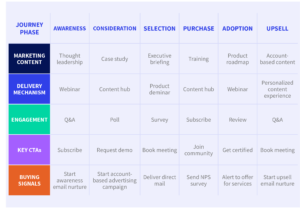3. Align to Experiences
When you’ve set up an experience then understand which stage of the journey you are trying to impact.
For an early stage educational webinar, the most appropriate way to engage the audience may be with Q&A and polling. This is especially useful when you have an external speaker that is on the webinar and could be sharing thought leadership or data. Engaging the audience by allowing them to submit questions to the thought leader can be very powerful, especially if they otherwise may not have access to this person, like an industry analyst. Polling can be very powerful to understand the maturity or level of understanding of a potential prospect as well. This can be deployed after data is shared then using a poll question to find out if the audience members are above or below the average that was shared.
For customers, engagement can look very different during digital experiences. During an experience where product roadmap information is being shared, feedback can be provided through a survey. Additionally, emoji reactions can be used to gather feedback about what features are most popular or anticipated.
